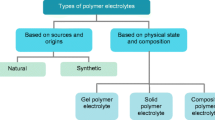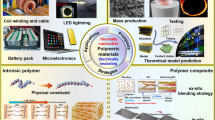Abstract
Highly uniform ac conductivity and dielectric permittivity of poly(aniline-co–o-nitroaniline) (PA-co-o-NA)s have been recorded by using electrochemical impedance spectroscopy in the frequency range of 10–2–107 Hz. Also, the unusual electrical behavior of PA-co-o-NA80 at low frequencies has been noticed. X-ray diffraction and differential thermal analysis techniques are used to study the crystallinity of the copolymer. The thermal stability of the copolymer is studied by thermogravimetric analysis which confirms the higher stability of copolymers than PAni. Atomic force microscopy measurement highlights the higher smoothness of the copolymer’s surface as compared to PAni.











Similar content being viewed by others
References
Shirakawa H, Edwin JL, Macdiarmid A, Chiang CK, Heeger AJ (1977) Synthesis of electrically conducting organic polymers: halogen derivatives of polyacetylene, (CH)x. JCS Chem Comm. https://doi.org/10.1039/c39770000578
Waware US, Hamouda AMS, Rashid M, Kasak P (2018) Towards the higher solubility and thermal stability of poly(aniline-co-m-bromoaniline). Ionics 24 (12):3837-3844
Lee K, Cho S, Park SH, Heeger AJ, Lee C-W, Lee S-H (2006) Charge transport and the electrodynamic response of a conducting polymer. Nature 44:4
Bai S, Zhao Y, Sun J, Tian Ye, Luo R, Li D, Aifan, (2015) Ultrasensitive room temperature NH3 sensor based on a graphene–polyaniline hybrid loaded on PET thin film. Chen ChemCommun 51:7524
Krishna D, Arun B, Biswajit S (2016) Tuning of electrical and optical properties of polyaniline incorporated functional paper for flexible circuits through oxidative chemical polymerization. RSC Adv 6:94795–94802
Feng X et al (2019) Engineering crystalline quasi-two-dimensional polyaniline thin film with enhanced electrical and chemiresistive sensing performances. Nature Comm. https://doi.org/10.1038/s41467-019-11921-3
Waware U S, A.M.S. Hamouda, Majumdar D (2020) Synthesis, characterization and physicochemical studies of copolymers of aniline and 3-nitroaniline. Polym Bull 77:4469–4488
Waware U.S, Mohd Rashid, A.M.S.Hamouda, Rohana Adnan (2020) Highly crystalline and thermally stable poly (aniline-co-2-nitroaniline). Polym Bull. https://doi.org/10.1007/s00289-020-03153-z
Koval’Chuk E.P et al. (2001) Copolymers of aniline and nitro aniline: Part II Physicochemical properties. Mater Chem Phys 70:38–48
Savitha P, Sathyanarayana DN (2004) Synthesis and characterization of soluble conducting poly (o-/m-toluidine-co-o-nitroaniline). Synth Metals. https://doi.org/10.1016/j.synthmet.2004.04.024
Yahya A. Ismail, Afaq Ahmad, Faiz Mohammad, (2008) Synthesis, Electrical, Electronic and Charge Transport Properties of Poly(aniline‐co‐ ‐toluidine) . J Macromol Sci Part A 45 (8):650-657
Joseph N, Varghese J, Sebastian MT (2015) Self-assembled polyaniline nanofibers with enhanced electromagnetic shielding properties. RSC Adv 5:20459–20466
Wang L, Wu T, Du S, Pei M, Guo W, Wei S (2016) High performance supercapacitors based on ternary graphene/Au/polyaniline (PANI) hierarchical nanocomposites. RSC Adv 6:1004–1011
Maity N, Kuila A, Das S, Mandal D, Shit A, Nandi AK (2015) Optoelectronic and photovoltaic properties of graphene quantum dot–polyaniline nanostructures. J Mater Chem A 3:20736–20748
Li M, An C, Marszalek T, Baumgarten M, Mullen K, Pisula W (2016) Adv Mater 28:2245–2252
Waware U.S, ,Hamouda A.M.S, Mohd Rashid , Peter Kasak (2018) Binding energy, structural, and dielectric properties of a thin film of poly(aniline-co-m-fluoroaniline). Ionics 24:3249–3257
Okutan M, Yavuz E, AhlatcıoğluÖzerol E et al (2020) Impedance spectroscopy of polyaniline coated hydrogel. Polym Bull. https://doi.org/10.1007/s00289-020-03295-0
Warare US, Rashid M, Hamouda AMS (2019) Synthesis and characterization of electrically conductive poly (aniline-co-3-bromoaniline) nanocomposites. Ionics 25:2669–2676
Kwon AH, Conklin JA, Makhinson M, Kaner RB (1997) Chemical synthesis and characterization of fluoro-substituted polyanilines. Synth Met 84:95
Umesh S, Waware, Mohd Rashid, Summers G.J (2016) An overview of physical properties of poly (Aniline-Co-2-Fluoroaniline). JMEST, 3(1)
Zho WS, Cromak K, MacDiarmid AG (1991) Effect of sulfonic acid group on polyaniline backbone. J Am Chem Soc 113:2665
Wei Yen, Hariharan Ramakrishnan, Patel Sandeep A (1990) Chemical and electrochemical copolymerization of aniline with alkyl ring-substituted anilines. Macromolecules 23:758–764
Conklin Jeanine A, Huang Shu-Chuan (1995) Thermal properties of polyaniline and poly (aniline-co-o-ethylaniline). Macromolecules 28:6522–6527
Wunderlich B (1990) Determination of polymer crystallinity by DSC. Therm Anal Acad Press 2:417–431
Blain RL (2002) TN 48 Polymer heats of fusion TA instruments. New Castle, DE
Waware US, Rashid M, Hamouda AMS (2019) Poly(aniline-co-3-aminophenol): enhanced crystallinity and solubility. Appl Phys A 125 (12)
Peter A, Julio de P The Physical Chemistry, 10th Ed, Oxford university press, pp 663
Cihaner A, Onal AM (2001) Synthesis and characterization of fluorine-substituted polyanilinesEur. Poly J 37:1767
Maity N, Kuila A, Das S, Mandal D, Shit A, Nand AK (2015) Optoelectronic and photovoltaic properties of graphene quantum dot–polyaniline nanostructures. J Mater Chem A 3:20736
Chakraborty P, Bairi P, Mondal S, Nandi AK (2014) Co-assembled conductive Hydrogel of N-Fluorenylmethoxycarbonyl Phenylalanine with Polyaniline. J PhysChem B 118:13969
Acknowledgments
The Qatar university, Doha, and the Universiti Sains Malaysia, are gratefully acknowledged for the post-doctoral position and research facilities. One of the author acknowledges Universiti Sains Malaysia (USM), Penang Malaysia, 11800, for the financial support through short-term grant no. 304.PKIMIA.6315473.
Author information
Authors and Affiliations
Corresponding authors
Additional information
Publisher's Note
Springer Nature remains neutral with regard to jurisdictional claims in published maps and institutional affiliations.
Rights and permissions
About this article
Cite this article
Waware, U.S., Rashid, M., Summers, G.J. et al. Poly(aniline-co-o-nitroaniline): transport properties using electrochemical impedance spectroscopy. Polym. Bull. 78, 6983–6998 (2021). https://doi.org/10.1007/s00289-020-03445-4
Received:
Revised:
Accepted:
Published:
Issue Date:
DOI: https://doi.org/10.1007/s00289-020-03445-4




